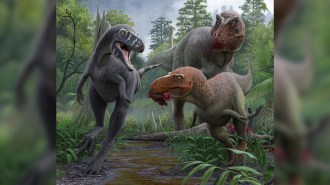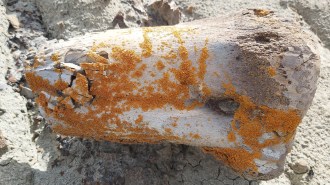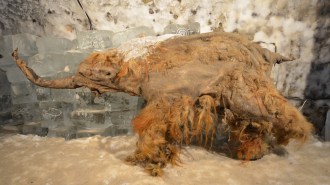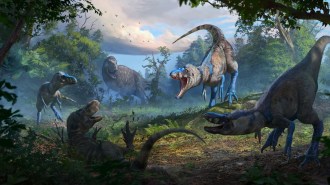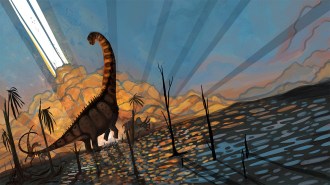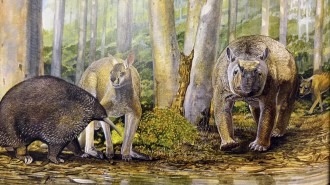Veggie Bites: Fossil suggests carnivorous dinosaurs begat vegetarian kin
The same Chinese rocks that have yielded evidence of new groups of feathered dinosaurs in the past few years have now surrendered remains of a creature that had rodentlike incisors and a hefty overbite. Scientists describing the new species say its remains provide the first distinct dental evidence for plant-eating habits among theropod dinosaurs, a class made famous by its carnivores, including Tyrannosaurus rex.

Fossils of the creature, whose genus name, Incisivosaurus, refers to its prominent front teeth, were unearthed from sediments deposited more than 128 million years ago in what is now northeastern China. Xing Xu of the Institute of Vertebrate Paleontology and Paleoanthropology in Beijing and his colleagues describe the unusual dinosaur in the Sept. 19 Nature.
The large worn areas on Incisivosaurus‘ front teeth, as well as smaller ones on most of its cheek teeth, indicate that upper and lower teeth made contact during chewing, as they do in modern herbivores. Also, the animal’s teeth lack small serrations that appear on many of the meat-shearing, daggerlike teeth of this dinosaur’s carnivorous cousins.
“It’s hard to imagine that this creature isn’t largely, if not wholly, herbivorous,” says Peter J. Makovicky, a paleontologist at the Field Museum in Chicago. Fossils from slightly older sediments in the region indicate that Incisivosaurus lived in a forest rife with conifers and shrubs.
Previous finds have offered circumstantial evidence that some theropods ate plants, says Philip Currie of the Royal Tyrrell Museum in Drumheller, Alberta. Those clues include gastroliths, or stomach stones, that would have ground ingested vegetation to a pulp. However, Currie says that Incisivosaurus “was clearly chomping up plants.”
Although the animal’s vegetarian lifestyle would be unusual among theropods, Makovicky points out that species can evolve to fill unoccupied ecological niches. For example, carnivorous mammals’ descendants that now shun meat include honey badgers, bamboo-eating pandas, and termite-slurping aardwolves.
Several features of Incisivosaurus‘ skull and the age of the sediments from which the animal’s fossil remains were unearthed suggest the creature is the oldest member of a group of theropods called oviraptors.
If so, the new find could help settle a paleontological debate. The birdlike features of one oviraptor, Caudipteryx, led some scientists to argue that the species was actually a flightless bird (SN: 8/19/00, p. 119). However, several features of Incisivosaurus suggest that Caudipteryx and other oviraptors developed their avian features not through inheritance from birds but through convergent evolution. Via that process, species with different evolutionary origins can develop outwardly similar shapes if they occupy similar ecological niches.
The Incisivosaurus specimen clears up where oviraptors fit into the dinosaur hierarchy, says Currie. Thomas R. Holtz Jr., a vertebrate paleontologist at the University of Maryland in College Park, agrees: Incisivosaurus “helps solve the debate simply because it’s so primitive.”
****************
If you have a comment on this article that you would like considered for publication in Science News, please send it to editors@sciencenews.org.

